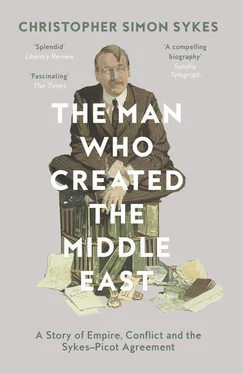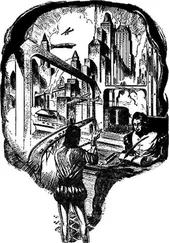Though the samples removed from Sykes’s grave have revealed nothing so far, there is always hope that they may in the future. New advances in technology have allowed scientists to take DNA samples from dinosaurs that died thousands of years ago, and it is known that even in circumstances where it has been poorly preserved, a virus can leave a genetic footprint. So the chance exists that in the future a vaccine may be created that has its origins in tissue taken from the body of Mark Sykes, and which would protect the world from an H5N1 pandemic that could, with intercontinental travel as common as it is today, kill billions. If that were to happen it would be a great posthumous legacy for a man who has been reviled for what he achieved in his lifetime, namely the creation of what is known today as the Middle East through the Sykes–Picot Agreement. When he signed his name in 1916 to this piece of diplomacy, which has been since derided as ‘iniquitous’, ‘unjust’ and ‘nefarious’, he was only thirty-six years old.
On 21 April 1900, the eve of his departure for South Africa to fight in the Boer War, the 21-year-old Mark Sykes paid a visit to his former tutor, Alfred Dowling, who told him: ‘How it is that you are no worse than you are, I cannot imagine.’ 1These may have seemed harsh words spoken to a man who was facing possible death on the battlefield, but they were intended as a compliment from a friend who knew only too well what Sykes had had to overcome: a childhood that had left him filled with bitterness and of which he had written, only four days earlier: ‘I hate my kind, I hate, I detest human beings, their deformities, their cheating, their cunning, all fill me with savage rage, their filthiness, their very stench appalls [ sic ] me … The stupidity of the wise, the wickedness of the ignorant, but you must forgive, remember that I have never had a childhood. Remember that I have always had the worst side of everything under my very nose.’ 2The childhood, or lack of it, of which Sykes spoke in this letter to his future fiancée, Edith Gorst, had been a strange and lonely one, spent in a large isolated house that stood high up on the Yorkshire Wolds. Sledmere House had been the home of the Sykes family since the early eighteenth century, when it had come into their possession through marriage. In the succeeding decades, as the ambitions and fortunes of the family had increased, along with their ennoblement to the Baronetcy, so had the size of the house, which had grown from a modest gentleman’s residence of the kind that might have been built in the Queen Anne period to a grand mansion, the design of which had its origins in schemes drawn up by some of the great architects of the day, such as John Carr and Samuel Wyatt. Built in the very latest neo-classical style, it had a central staircase hall, off which, on the ground floor, were a Library, Drawing Room, Music Room and Dining Room, all with the finest decoration by Joseph Rose, while much of the first floor was taken up by a Long Gallery doubling as a second Library that was as fine as any room in England.
This was the house in which Mark Sykes was brought up, as an only child, the progeny of an unlikely couple, both of whom were damaged by their upbringing. His father, Sir Tatton Sykes, had been a sickly boy, a disappointment to his own father, also named Tatton, an old-fashioned country squire, of the type represented in literature by characters such as Fielding’s Squire Western and Goldsmith’s Squire Thornhill. He was hardy in the extreme, and Tatton, his firstborn, lived in constant fear of a father who had no time for weakness, and was only too free with both the whip and his fists, believing that the first precept of bringing up children was ‘Break your child’s will early or he will break yours later on.’ This principle, better suited to a horse or dog, was followed exactly by Tatton, who imposed it upon his own offspring, six girls and two boys, in no uncertain terms.
The young Tatton despised everything his father stood for, and grew up a neurotic, introverted child who developed strong religious beliefs and could not wait to get away as soon as he was of age. As it happened he reached adulthood at a time in history when the world was opening up to would-be travellers. The railways were expanding at great speed. Brunel had just built the SS Great Western , the largest passenger ship in the world, to revolutionize the Atlantic crossing. Steamships regularly travelled to and from India, and on the huge American tea clippers it was possible for a passenger to sail from Liverpool all the way to China. For someone as painfully shy and who valued solitude as much as him, travel to a distant place was the perfect escape, and in the years between his leaving Oxford and the eventual death of his father in 1863, Tatton visited India, America, China, Egypt, Europe, Russia, Mexico and Japan, making him one of the most travelled men of his generation. But of all the places he visited, none struck him as forcibly as the lands that made up the Ottoman Empire, stretching from North Africa to the Black and Caspian Seas, where he was particularly fascinated by the myriad religious sites and shrines, which appealed to his own powerful spiritual beliefs.
Tatton was in Egypt when, on 21 March 1863, he was brought the news of his father’s death. ‘Oh indeed! Oh indeed!’ was all he could manage to mutter. 3He returned home with only one thing in mind: to take a new broom to the whole place He sold all his father’s horses, and his pack of hounds, and had all the gardens dug up and raked over. These had been his mother’s domain and he set about destroying them with relish, demolishing a beautiful orangery and dismantling all the hothouses in the walled garden, no doubt in revenge for her not having been more protective of her children. When all was done he embarked upon his own passion, one that had grown out of his early travels through the Ottoman Empire, when he had been astonished by the religious fervour he had encountered amongst the large number of pilgrims to the holy cities. The considerable quantity of crosses and memorials which had been erected along the roads as reminders of these journeys had made a deep and lasting impression upon him, and he had returned home determined that some similar demonstration of the people’s faith should be made in the East Riding of Yorkshire. He therefore decided that he would use some of his immense wealth to build churches where none stood, building and restoring seventeen during his lifetime.
As the owner of a beautiful house and a great estate, now scattered with fine churches, it soon became clear that Tatton would need someone to hand them all on to, especially since he was nearing fifty. His introverted character, however, did not make the path of finding a wife a smooth one, and when he did finally get married it was to a girl who was thrust upon him. Christina Anne Jessica Cavendish-Bentinck was the daughter of George ‘Little Ben’ 4Cavendish-Bentinck, Tory MP for Whitehaven, and a younger son of the fourth Duke of Portland. Though Jessie, as she was known, was no beauty, having too square a jaw, she was certainly handsome, with large, dark eyes, a sensual mouth and curly hair which she wore up. She was intelligent and high-spirited, and had political opinions, which at once set her apart from the average upper-class girl. She also loved art, a passion that may have had its roots in her having sat aged five for George Frederick Watts’s painting Mrs George Augustus Frederick Cavendish-Bentinck and Her Children . She later developed a talent for drawing, and her hero was John Ruskin, whom she had met and become infatuated with, while travelling with her family in Italy in 1869.
Jessie’s mother, Prudence Penelope Cavendish-Bentinck, was a formidable woman of Irish descent who went by the nickname of ‘Britannia’. From the very moment Jessie had become of marriageable age, she was determined to net her daughter a rich and influential husband. According to family legend the pair of them were travelling through Europe in the spring of 1874 when, as they were passing through Bavaria, Jessie became mysteriously separated from the party. Faced with the unwelcome prospect of spending the night alone, she was obliged to turn for help to the middle-aged bachelor they had just befriended, Sir Tatton Sykes. He, quite correctly, made sure that she was looked after, and, the following morning, escorted her to the station to catch the train to join up with her family. However, when she finally met up with them, her mother feigned horror at the very thought of her daughter having been left unchaperoned overnight in the company of a man they barely knew. As soon as she was back in London, Britannia summoned the hapless Tatton to the family house at no. 3 Grafton Street and accused him of compromising her daughter. It was a shrewd move, for Tatton, to whom the idea of any kind of scandal was anathema, agreed at once to an engagement, to be followed by the earliest possible wedding.
Читать дальше











